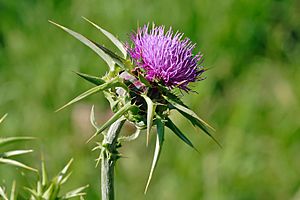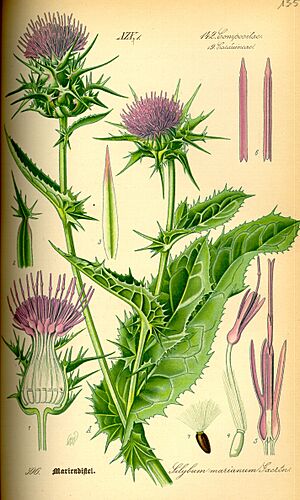Milk thistle facts for kids
Quick facts for kids Milk thistle |
|
|---|---|
 |
|
| Scientific classification | |
| Genus: |
Silybum
|
| Species: |
marianum
|
| Synonyms | |
|
Carduus marianus L. |
|
The Milk Thistle (scientific name: Silybum marianum) is a type of thistle. It has many common names, like blessed milkthistle, Marian thistle, or Saint Mary's thistle. This plant can live for one or two years. It belongs to the Asteraceae family, which includes daisies and sunflowers.
Milk thistle has pretty red or purple flowers. Its leaves are shiny pale green with white veins. This plant first grew in Southern Europe and Asia. Now, you can find it all over the world.
Contents
What Does Milk Thistle Look Like?
Milk thistle is a tall plant that grows straight up. It can reach a height of 30 to 200 centimeters (about 1 to 6.5 feet). The plant often has a cone shape. Its stem has grooves and might feel a bit fuzzy. Very large plants can have hollow stems.
The leaves are long, from 15 to 60 centimeters (about 6 to 24 inches). They are usually deeply cut, with spiny edges, just like most thistles. The leaves are smooth and shiny green. They have distinct white veins that look like spilled milk.
The flowers are red-purple and grow in large heads. Each flower head is about 4 to 12 centimeters (about 1.5 to 5 inches) wide. In the northern parts of the world, they bloom from June to August. In the southern parts, they bloom from December to February. The flower heads are surrounded by special leaves called bracts. These bracts are smooth and have triangular, spiny edges. Each bract ends with a strong yellow spine.
After flowering, the plant produces black seeds. Each seed has a long, white, fluffy part called a pappus. This pappus acts like a tiny parachute. It helps the seeds float away in the wind. This way, the plant can spread its seeds far and wide.
Where Does Milk Thistle Grow?
The Milk Thistle originally comes from the Mediterranean region. This includes parts of Europe, like Greece, and stretches east into Iran and Afghanistan. It might also naturally grow near the coast of southeast England.
However, milk thistle has been taken to many other places. It now grows in North America, Hawaii, Australia, New Zealand, and Colombia. In some of these new places, it is considered an invasive weed. This means it can grow too much and harm local plants. Today, it also spreads as an invasive plant in many parts of Europe. This often happens because it was grown in fields and then escaped.
Milk thistle likes sunny and warm places. It often grows in areas that are regularly disturbed. You might find it on piles of rubble or at the base of sunny walls. It also grows in empty urban lots or on pastures where cattle graze. However, it does not like very dry or stony soils.
Scientists have also noticed that milk thistle might change how fires happen in new areas. When it invades a new place, fires might become more common or spread differently.
Growing Milk Thistle
Milk thistle is an easy plant to grow. It does not need much care. People mostly grow it as a medicinal plant. But it can also be used as a food source. It is mainly grown in Europe, but also in Asia and North America.
Even though milk thistle is a biennial plant (meaning it usually lives for two years), it is often grown as an annual plant (living for one year). This makes it easier to farm. If the plant gets what it needs, it can flower in its first year.
Milk thistle does not need rich soil. It can also handle dry weather. The best soil pH (how acidic or alkaline the soil is) is between 5.5 and 7.6. But it can grow in a wider range too. Farmers plant the seeds directly into the soil. They usually plant them about 1 to 1.5 centimeters deep. For the seeds to sprout, the temperature needs to be at least 2 degrees Celsius (about 36 degrees Fahrenheit).
Farmers can plant the seeds in autumn or spring. This depends on the weather in their area. Rows of plants are usually 40 to 75 centimeters apart. Each plant in a row is about 25 centimeters from the next. Milk thistle does not always need extra plant food. But farmers might add some fertilizer to get more plants. They might use about 50 kilograms of nitrogen, 30 kilograms of phosphorus, and 60 kilograms of potassium per hectare before planting.
Harvesting usually happens in July or August. The flowers do not all ripen at the same time. So, the best time to harvest is about two weeks after half of the flower heads are dry. Farmers can use a regular cereal combine harvester to collect the seeds. In Poland, farmers get about 1230 kilograms of seeds per hectare. These seeds contain about 26.5 kilograms of a special substance called silymarin.
What is Silymarin?
Milk thistle seeds contain a substance called silymarin. This is a mix of natural compounds. Traditional milk thistle extracts are made from these seeds. The seeds have about 4–6% silymarin. The extract itself is usually 65–80% silymarin. The rest is mostly fatty acids, like linoleic acid.
Silymarin is a complex group of molecules. It includes seven similar compounds called flavonolignans. It also has a flavonoid called taxifolin. One part of silymarin, called Silibinin, is often studied. It is a mix of two very similar forms, silybin A and silybin B.
Milk Thistle in Traditional Medicine
For hundreds of years, people have used milk thistle in traditional medicine. However, there is not enough strong scientific proof that it has any real medicinal effects. The research done so far has not been very good quality.
Silymarin is taken from milk thistle seeds. You can find it as a special extract. In 2019, Cancer Research UK said that much more research is needed. They want to see reliable clinical trials. This would help them know if milk thistle can help treat or prevent cancers.
Using milk thistle might cause some people to have an upset stomach. It can also cause allergic reactions in some individuals.
Is Milk Thistle Toxic?
Some studies have found that milk thistle supplements can have high levels of mycotoxins. These are harmful substances made by molds.
Milk Thistle and Animals
Milk thistle contains nitrate. Because of this, it can be harmful to animals like cattle and sheep. When these animals, called ruminants, eat potassium nitrate, bacteria in their stomachs break it down. This creates nitrite ions. These nitrite ions then combine with hemoglobin in their blood. Hemoglobin usually carries oxygen. But when it combines with nitrite, it forms something called methemoglobin. This stops the blood from carrying oxygen properly. The animal then suffers from a lack of oxygen, which is a type of oxygen deprivation.
See also
 In Spanish: Cardo mariano para niños
In Spanish: Cardo mariano para niños


